|
James Martin "Jay" Roberts (June 4, 1890 to July 28, 1932) | |
 Compositions Compositions | |
|
1912
That Raggy Military Tune [1,2]Song of the Mission Chimes
1. w/Don Bestor
2. w/Roger M. Lewis | |
Jay Roberts was born in 1890 in Oakland, California across the bay from the Barbary Coast of San Francisco, California, to Iowa native Jesse S. Roberts and Arkansas wife Ada P. Reynolds, who had been married on October 13th, 1887. He was one of three children born to the couple, one of which died before 1900, and his younger sister Memory Hope (11/1/1905). Jesse was a postal clerk and manager, and had helped to start up one of the first mail routes in Alaska, along with early dog sled delivery service between 1903 and 1906. It is unclear whether his family went with him to the northern frontier during that time.
Jesse would later be promoted to inspector in 1910, the superintendent of the San Francisco post office in 1915, and the Superintendent of Railway Service in 1916. As of the 1900 enumeration the family was living in Oakland at 1057 55th Street. Jay's first job as a substitute postman was very likely obtained for him by his father. 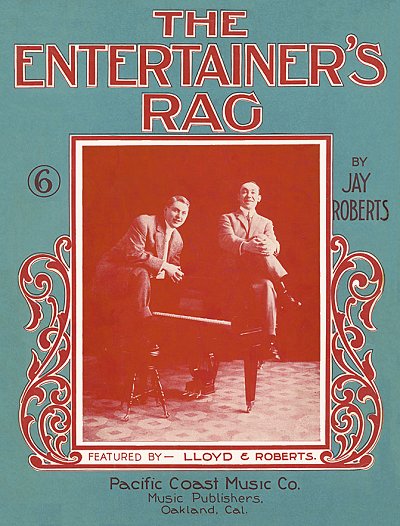 However, he followed his true desire to become an entertainer and ragtime pianist, starting his way through some of the more legitimate venues before making incursions into the less than proper ones.
However, he followed his true desire to become an entertainer and ragtime pianist, starting his way through some of the more legitimate venues before making incursions into the less than proper ones.
 However, he followed his true desire to become an entertainer and ragtime pianist, starting his way through some of the more legitimate venues before making incursions into the less than proper ones.
However, he followed his true desire to become an entertainer and ragtime pianist, starting his way through some of the more legitimate venues before making incursions into the less than proper ones.One of the earliest mentions of Jay as a pianist came when he was but 12, as per the San Francisco Call of August 31,1902:
CLEVER YOUNG PEOPLE WHO EXHIBITED THEIR TALENTS AT OAK LEAF CHAPTER'S PARTY
Once every year, Oak Leaf Chapter No. 3, Order of the [Easter] Star, devotes an evening to the children, and Thursday night at Masonic Temple twenty-five of more little people participated in a colonial entertainment that proved to be one of the most enjoyable affairs ever given by the order. All the children who took part in the recitations and musical part of the programme were costumed in the quaint style of colonial days and all acquitted themselves with great credit, much to the delight of the large crowd of friends and relatives who had assembled to enjoy the childish efforts… Piano solo, Jay Roberts; … "Yankee Doodle Chorus"—Jay Roberts, Harold Rutley, Elwood Peterson…
In all, three performance credits for were listed for the young Mr. Roberts that evening. Three and a half years later came an early mentions of Jay in the Oakland Tribune when he was not yet 16, printed on February 17, 1906, just two months before the devastating earthquake would partially destroy San Francisco:
To Give Musicale. To assist a most worthy and deserving lady, a musicale is to be given at the Glenwood, 1165 Washington Street, on Tuesday evening, February 20th, by Miss Belle Jones… The proceeds of the entertainment will be turned over to Miss Courtwright… She is very much in need of financial assistance… The program is as follows: Piano, Jay Roberts, duet, Mr. and Mrs. Augustus…
He performed at least twice during that event. Jay's talent did not go unnoticed at 15. In the April 6 Issue of the Tribune he was listed as part of an entertainment given "under the auspices of Faith Circle and Loyal Sons of the First Christian Church…" of which Jay was a member. In December, now 16, he was featured at the First Christian Church in a Christmas program, again playing a piano solo. The nature of the music that the teenager was playing at these events was not mentioned, but it can be assumed, given the venues, that it was something more genteel than ragtime or other popular music of the day.
The next located public mention of Roberts came on March 1, 1908, the day after Jay had attended, and likely played at a Leap Year party for socialite Vivian Tyler. Then there was a notable article in the May 11, 1908, edition of the Tribune:
The Drama 'A Noble Outcast' will be presented at Evell Hall on Friday Evening… under the auspices of the Loyal Sons of Faith Circle clubs of the First Christian Sunday School of this city, two of the most popular young people's church organizations around the bay… Jay M. Roberts has charge of the orchestra for the occasion, which means that the music will be of a high standard…
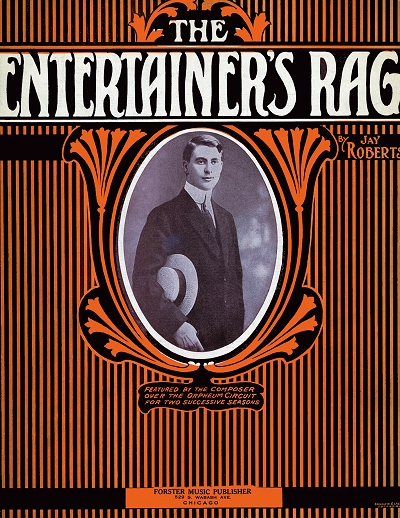 Again, this would not be ragtime. However, it did show high confidence in Jay's abilities as not just a musician but as a band or orchestra leader. Later in 1908, now 18 years old, Roberts started appearing in more functions that were not church related, usually as an accompanist but sometimes as a soloist. One of his last mentioned associations with the Loyal Songs was in November 1909, but in a slightly different context for a show given at Hamilton Auditorium, including the First Christian Church orchestra and:
Again, this would not be ragtime. However, it did show high confidence in Jay's abilities as not just a musician but as a band or orchestra leader. Later in 1908, now 18 years old, Roberts started appearing in more functions that were not church related, usually as an accompanist but sometimes as a soloist. One of his last mentioned associations with the Loyal Songs was in November 1909, but in a slightly different context for a show given at Hamilton Auditorium, including the First Christian Church orchestra and:Professor Mansfield's mandolin orchestra of twelve pieces… The management has been fortunate in securing the Hawaiian quartet for vocal and instrumental selections. Roberts and Roberts (Jay and Gus) of San Francisco [indicating a possible temporary relocation in domicile] will entertain with vocal solos and piano.
It is unclear who Gus Roberts was, but given other scant mentions he appears to have been the song and dance component of the act. In the 1910 census he was shown (sans a first name) as a performer and musician living in a San Francisco boarding house. His father, Jesse, had temporarily relocated the rest of the family north to Redding, California, where he ran the railway mail service just before his promotion. Now approaching just 20, Jay was drafted into vaudeville on the West Coast Orpheum Theatre circuit. His acceptance into this group was evidently a moment of great pride for him, and one that appeared to have a direct source. In high school, Roberts had an earnest musical coach whom he later thanked publicly for his tutelage. Ernest Wilbur Chamblin taught piano and harmony privately to many talented youths living in the San Francisco Bay Area, some of them achieving national fame in later years. In a 1920 tribute to him in the Berkely Daily Gazette, a 1910 letter from Jay was reprinted publicly thanking his influential musical mentor:
Cincinnati O., October 18, 1910, Mr. E.W. Chamblin, Professor of Piano and Voice…
Dear Professor:—I am taking this opportunity to inform you that I have just completed six successful weeks in the Orpheum vaudeville circuit as a concert pianist. My playing during this period has impressed the public so favorably and has been so thoroughly satisfactory to the management that I have just been offered booking for an [sic] European tour upon the completion of my present engagement, which includes nearly all the large cities of the east and south and finishes up in Los Angeles, Oakland and San Francisco in May of next year…
It gives me great pleasure to state that you are indirectly the source of my success, for it is due to your original, aggressive and up-to-date methods of teaching that I am able today to perform accurately and with the dispatch of a recognized professional.
The rapid acquirement of technic [sic], touch and finished playing which is made possible by your skill in saving time through the judicious elimination of all that is ridiculous and unnecessary, and the constant and persistent concentration which you compel upon only those essentials which make for rapid development, class you as an efficient, modern instructor of either teacher or pupil.
While with the Orpheum organization, Jay soon became associated with two different artists. One was George Lee Lloyd, a local singer who had recently replaced his ailing brother on stage as part of another act. Lloyd and Roberts, frequently billed as "drawing room entertainers, lasted only a little less than a year as an act, but Lloyd does appear on the initial cover of Jay's one great hit composed that same year, The Entertainer's Rag. This somewhat challenging piano rag was written specifically to be played in cutting contests. It had little in the way of original themes, and was mostly a cut and paste affair derived from well-known tricky piano licks. One of those was in the trio with the juxtaposition of Yankee Doodle in the left hand and Dixie's Land in the right. Printed by Pacific Coast Music Publishers (possibly his own firm), 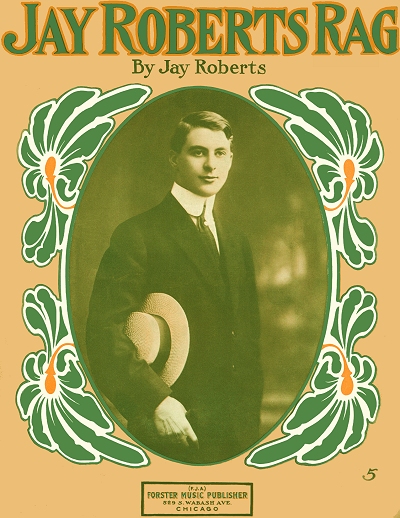 it was probably in part promotional material for the act, although Jay soon had a different partner. In early October of 1911, Lloyd's brother, whom he had replaced, died, and he soon left the stage after their run was through later in the month. Roberts and his co-publisher, listed only as Payne in the copyright, sold The Entertainer's Rag to F.J.A. Forster Music in Chicago in 1912, as it had gained a great reputation in just a short time on the market.
it was probably in part promotional material for the act, although Jay soon had a different partner. In early October of 1911, Lloyd's brother, whom he had replaced, died, and he soon left the stage after their run was through later in the month. Roberts and his co-publisher, listed only as Payne in the copyright, sold The Entertainer's Rag to F.J.A. Forster Music in Chicago in 1912, as it had gained a great reputation in just a short time on the market.
 it was probably in part promotional material for the act, although Jay soon had a different partner. In early October of 1911, Lloyd's brother, whom he had replaced, died, and he soon left the stage after their run was through later in the month. Roberts and his co-publisher, listed only as Payne in the copyright, sold The Entertainer's Rag to F.J.A. Forster Music in Chicago in 1912, as it had gained a great reputation in just a short time on the market.
it was probably in part promotional material for the act, although Jay soon had a different partner. In early October of 1911, Lloyd's brother, whom he had replaced, died, and he soon left the stage after their run was through later in the month. Roberts and his co-publisher, listed only as Payne in the copyright, sold The Entertainer's Rag to F.J.A. Forster Music in Chicago in 1912, as it had gained a great reputation in just a short time on the market.Roberts was becoming known to be quite the virtuoso as a pianist, one of the finest on either coast, and regularly appeared in vaudeville and other stage performance venues. At an imposing (for that time) 6 feet tall, Roberts likely cut quite a swath cutting contests or vaudeville performances. He wrote a piece about California heritage, one of his only three tunes with lyrics, Song of the Mission Chimes. The second was a contribution to A Raggy Military Tune with Don Bestor and Roger Lewis, both well-known Chicago writers. How this association came about is unknown, but it may be during his travels on the circuit. The third was a comic song titled Mademoiselle O'Toole. The only other known pieces by Roberts were two other rags, the self-named Jay Roberts Rag and his higher quality and more original Joy Rag, both also sold to Forster.
There was no clear evidence found that Roberts went on the European leg of the Orpheum tour as mentioned in his letter to Professor Chamblin. However, he appeared in Los Angeles on the Orpheum circuit for a while in the fall and winter of 1911 to 1912, mostly as a solo ragtime pianist but sometimes with Lloyd until the latter left the stage. In the 1912 California Voter Registration for Alameda County Jay was shown as still living with his parents at 839 Athens Avenue in Oakland, listed as a musician, but also as living alone a few blocks off at 924 28th Street, likely having moved out while the roll was being taken. He spent a week in San Francisco in late January 1912 playing his own numbers and others as a celebrity song plugger at The New Song Shop in Oakland, a Forster outlet, before returning to Los Angeles to complete his engagements there.
When he was back in San Francisco in March, Roberts picked up a new vocalist partner, Miss Elsie Schuyler. They were put together by manager George Ebey of the Orpheum who chose some of the material and the format. After their debut in early March, 1912, the Oakland Tribune lavished praise upon both.
Elsie Schuyler and Jay Roberts, in vocal and instrumental singing — pianos often sing, you know — delighted yesterday's audience to the extent of several encores… Miss Schuyler would do well with work that is frankly character drawing. She has a good singing voice, a fund of personal appeal and an artistic idea of a grimace. Roberts, at the piano, is a master performer and carried off his share of the honors with original rights.
A similar review stated that:
Jay Roberts is a brilliant pianist whose artistry has enabled him to stand out, pre-eminent above the score of gifted pianists who have been seen in various offerings in vaudeville during the last few years. He suggests 'class' in every way, and, with Miss Schuyler, embodies the spirit of modern vaudeville — talent, allied with grace of manner and clean-cut personal charm.
In 1913 this "clean-cut" pianist would take on another partner, a Miss Gould. They were featured for part of 1913 at the Avenue Cafe in Oakland, with advertising calling on no less than Irving Berlin to gain attention: "Come On and Hear, Come On and Hear, 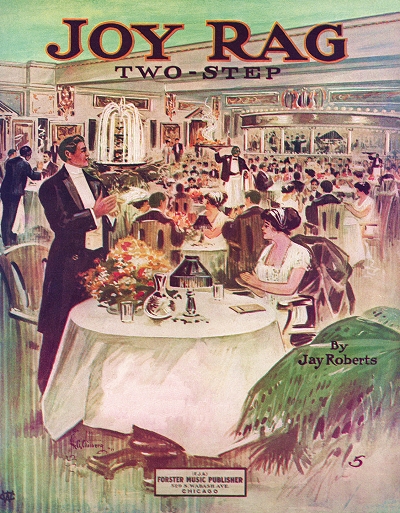 JAY ROBERTS Assisted by Miss Gould." Even with the amount of work he was getting, and his Entertainer's Rag now fetching the inflated suggested price of $1.00 per copy, and with everything seeming to go his way, Jay managed to create his own run of trouble.
JAY ROBERTS Assisted by Miss Gould." Even with the amount of work he was getting, and his Entertainer's Rag now fetching the inflated suggested price of $1.00 per copy, and with everything seeming to go his way, Jay managed to create his own run of trouble.
 JAY ROBERTS Assisted by Miss Gould." Even with the amount of work he was getting, and his Entertainer's Rag now fetching the inflated suggested price of $1.00 per copy, and with everything seeming to go his way, Jay managed to create his own run of trouble.
JAY ROBERTS Assisted by Miss Gould." Even with the amount of work he was getting, and his Entertainer's Rag now fetching the inflated suggested price of $1.00 per copy, and with everything seeming to go his way, Jay managed to create his own run of trouble.Unfortunately for him, Roberts seemed to live a bit beyond his means during the 1910s, which created suspicion with the San Francisco Police Department, who often kept an eye on well-known public figures. One real estate item showed up in the Oakland Tribune in September, 1912, when he transferred a couple of valuable lots in Alton Park from himself to his mother, being just a bit over the age of 22. Shortly after Christmas he purchased a fairly nice Regal 25 automobile. By the end of 1913 Jay had obtained a small airplane, a very ostentatious purchase even for a working vaudeville pianist. It was allegedly for his own pleasure. Stage appearances by Roberts on the Orpheum vaudeville circuit appear to have dropped off during 1914.
Having been perhaps too prominently on the radar of Bay Area authorities, Roberts relocated to Los Angeles around 1915 after having finished an engagement at the Panama Pacific World's Fair in San Francisco. Late in the year he secured a semi-regular gig at Jake Fieber's Rathskeller Cafe in downtown Los Angeles. There he was billed as "The Aviator. Champion ragtime pianist of the world. Late of Orphum circuit." During this transition period Jay spent more time in the air than at the piano, flying having become a strong passion. He participated in exhibitions all along the west coast from Mexico to Seattle, Washington. Through this passion he met Miss Grace E. Rogers, and they were married on July 4, 1916 as per the Los Angeles Herald of that same date:
A romance which had its inception on an aviation field in Washington, culminated today when Jay M. Roberts, daring aviator, claimed as his bride Miss Grace E. Rogers of Elma, Washington…
Miss Rogers with her uncle Col. Charles H. Rogers, U.S.A. retired, and now deceased, were viewing the thrilling flights of birdmen on the aviation fields near Seattle two years ago when she was attracted by the daring and skill of one of the youngest aviator. A chance meeting with the aviators at the close of the exhibitions afforded Dan Cupid an opportunity. The chance meeting ripened into engagements.
While Miss Rogers was visiting friends here a week ago she learned that Roberts narrowly escaped death while making an exhibition flight in Venice [California]. The hose leading from the engine to the radiator of the biplane burst while Roberts was more than 2000 feet above the field. Although scalded by the escaping water, Robert volplaned to earth.
It was decided as Roberts lay on a hospital cot that marriage should take place July Fourth, the wedding anniversary of Miss Rogers' mother…
The downward turning point in Jay's life came less than two weeks later after a somewhat public arrest in for opium possession, accompanied by much speculation about his routinely flying it in from Mexico and acting as dealer. A somewhat creative writer from the Oakland Tribune relayed these issues in their July 17th, 1916, issue:
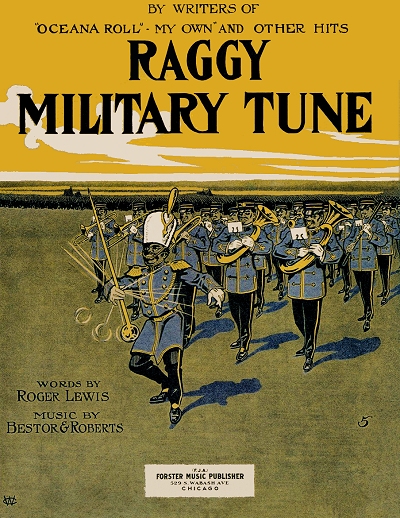 The snappy ragtime songs that Jay Roberts, former Oakland song writer, tickled vaudeville palates with were concocted much as De Quincey's literary mosaics were—with the aid of opium. A mind stimulated by drugs evolved the theatrical hits that attracted attention throughout the country before the author, forsaking the music, turned to aviation.
The snappy ragtime songs that Jay Roberts, former Oakland song writer, tickled vaudeville palates with were concocted much as De Quincey's literary mosaics were—with the aid of opium. A mind stimulated by drugs evolved the theatrical hits that attracted attention throughout the country before the author, forsaking the music, turned to aviation.This is the strange confession that followed a raid by federal officers on the song writer's home in Los Angeles. Roberts and his bride of only a few days and his mechanician [plane mechanic]… were apprehended by the government inspectors, Mrs. Roberts being released when it was ascertained that she had nothing to do with the affair save to attempt to cure her husband of the habit that had gripped him…
"The hop is mine," declared the writer. "I have tried to break myself of it and am now under a doctor's care. Another month would have seen me cured. I have used it for six years, driven to it by brain fag [fatigue] when writing songs. My wife knew it before she married me." …
Roberts had been under surveillance for some weeks. It had been noticed that he made frequent trips to the Mexican border in his machine and finally he was suspected of bringing opium into the country. Early yesterday morning detectives surrounded his house, seized his Chinese servant and entered, to find the drug. Roberts confessed at once that the opium was his. His mechanician was held as an accomplice.
Unable to recover professionally from this public gaffe, Roberts spent the remainder of his life as an aviator and itinerant performer. He appeared in the California voter registration rolls in late 1916 at 1333 S. Burlington Avenue, Los Angeles, his occupation listed as an aviator. Roberts was also shown in Los Angeles on his 1917 draft registration, again as an aviator and not a musician, with his contact being his Grace who had remained with him through the trouble. In 1919 Jesse Roberts died at age 54. In his obituary it mentioned Jay as well as his sister Memory as two "well-known musicians," although in what capacity the younger Roberts performed at age 13 was difficult to ascertain.
There were reports from a bit after the time he moved to Southern California that in addition to the opium Roberts may have been flying in guns and armaments to Pancho Villa during the Mexican Revolution. But he also depended on music for some income, and perhaps as a cover for his other unsavory activities. In the 1920 enumeration Jay and Grace were shown as still living near downtown Los Angeles, and he listed his occupation as a theater musician, with Grace working as a drugstore clerk. Roberts left the United States around 1922, possibly with Grace who cannot be definitively found in the 1930 census. He eventually settled in Balboa, Ancon, Panama in the American Canal Zone, living often from day to day and picking up work as a pilot or musician, or even a laborer, whenever he could find it.
Things were difficult during the Great Depression in Panama in the early 1930s, as the only real income at that time in the Canal Zone was from servicing the ships passing through the canal, and their numbers had decreased along with international trade. Jay may have been suffering both economically and from substance withdrawal or the constant need for substances. On July 28, 1932, a few weeks after his 42nd birthday, Jay Roberts jotted down a quick note which stated he was "just tired of life and pain." He then shot himself through the head with a revolver. His obituary stated simply that he was a musician, and gave no other clues as to his time in Panama or the cause of his suicidal pain. The dynamic Entertainer of the Barbary Coast was no more. However, during the resurgence of ragtime on the new medium of long playing records in the 1950, The Entertainer's Rag as played by stellar Hollywood pianist Ray Turner was the first cut on Honky-Tonk Piano, the Capitol Records release that heralded a comeback for the genre that has not left us since.